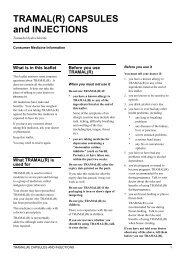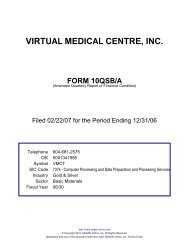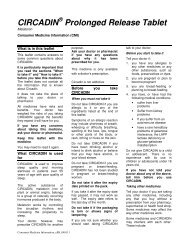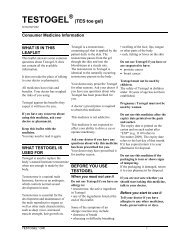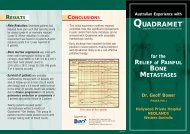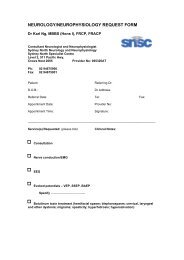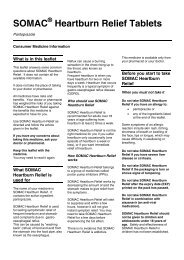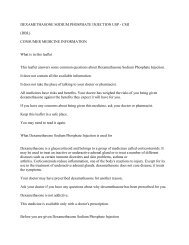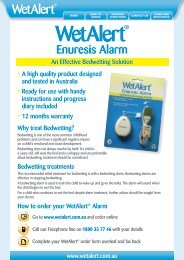VIRTUAL MEDICAL CENTRE INC
virtual medical centre, inc. form 10-k
virtual medical centre, inc. form 10-k
Create successful ePaper yourself
Turn your PDF publications into a flip-book with our unique Google optimized e-Paper software.
We may not be able to obtain sufficient capital and may be forced to limit the scope of our operations or discontinue operations.<br />
If we are not able to secure the financing we need at the current time or in the future, we may not be able to undertake any planned<br />
operational expansions or acquisitions. As a result, we may have to modify our business plans accordingly or may be required to discontinue our<br />
business operations. There is no assurance that additional financing will be available to us when needed, or if made available, on terms that are<br />
favorable to us. Further, any future capital investments could dilute or otherwise materially and adversely affect the holdings or rights of our<br />
existing shareholders. In addition, new equity or convertible debt securities issued by us to obtain financing could have rights, preferences and<br />
privileges senior to those granted to existing shareholders.<br />
We may make acquisitions or investments in new businesses, products or technologies that involve additional risks, which could disrupt<br />
our business or harm our financial condition or results of operations.<br />
As part of our business strategy, we have made, and expect to continue to make, acquisitions of businesses or investments in<br />
companies that offer complementary products, services and technologies. Such acquisitions or investments involve a number of risks, including :<br />
• Assimilating operations and products may be unexpectedly difficult;<br />
• Management’s attention may be diverted from other business concerns;<br />
• We may enter markets in which we have limited or no direct experience;<br />
• We may lose key employees, customers or vendors of an acquired business;<br />
• The synergies or cost savings we expected to achieve may not be realized;<br />
• We may not realize the value of the acquired assets relative to the price paid; and<br />
• Despite our diligent efforts, we may not succeed at integration, quality control or other customer issues.<br />
These factors could have a material adverse effect on our business, financial condition and operating results. Consideration paid for<br />
any future acquisitions could include our stock or require that we incur additional debt and contingent liabilities. As a result, future acquisitions<br />
could cause dilution of existing equity interests and earnings per share. Before we enter into any acquisition, we perform significant due<br />
diligence to ensure the potential acquisition fits with our strategic objectives. In addition, we believe we have adequate resources and appropriate<br />
integration procedures to transition the newly acquired company efficiently.<br />
We may not be able to manage our growth effectively.<br />
The expansion necessary for us to fully exploit the market for our products and services requires an effective planning and<br />
management process. Growth, if it occurs, will likely place a significant strain on our managerial, operational and financial resources. To<br />
manage our growth, we must implement and improve our operational system and expand, train and manage our employee base. There can be no<br />
assurance that our systems, procedures or controls will be adequate to support operations or that management will be able to achieve the<br />
expansion necessary to fully exploit the market for our products and services, and the failure to do so would have a material adverse effect on<br />
our business, operations and financial condition.<br />
Our results of operations could be adversely affected by impairment of our goodwill or other intangible assets.<br />
When we acquire a business, we record goodwill equal to the excess of the amount we pay for the business, including liabilities<br />
assumed, over the fair value of the tangible and intangible assets of the business we acquire. Goodwill and other intangible assets that have<br />
indefinite useful lives must be tested at least annually for impairment. The specific guidance for testing goodwill and other non-amortized<br />
intangible assets for impairment requires management to make certain estimates and assumptions when allocating goodwill to reporting units<br />
and determining the fair value of reporting unit net assets and liabilities, including, among other things, an assessment of market conditions,<br />
projected cash flows, investment rates, cost of capital and growth rates, which could significantly impact the reported value of goodwill and<br />
other intangible assets. Fair value is generally determined using a combination of the discounted cash flow, market multiple and market<br />
capitalization valuation approaches. Absent any impairment indicators, we generally perform our impairment tests annually in the fourth quarter,<br />
using available forecast information.<br />
8



